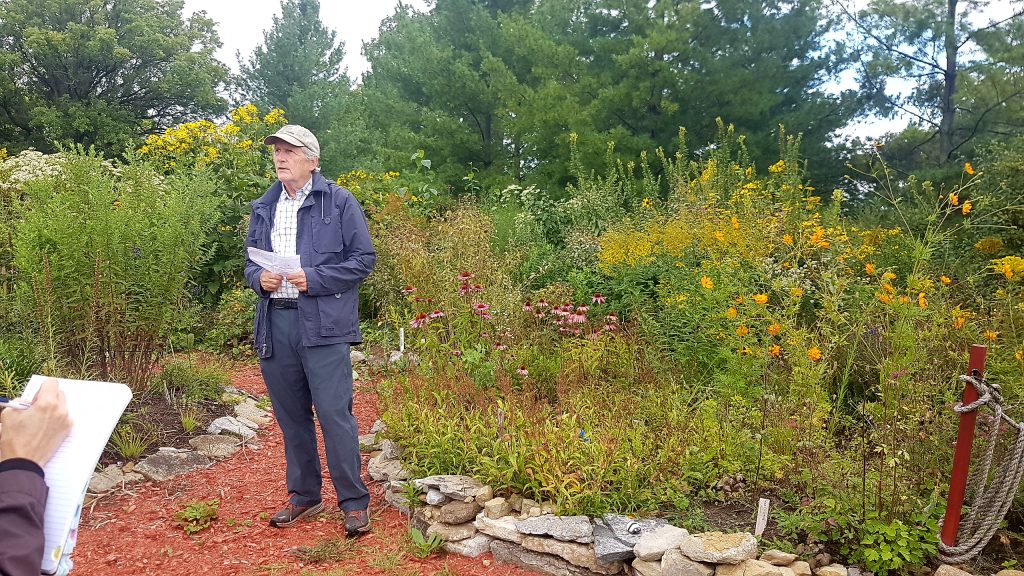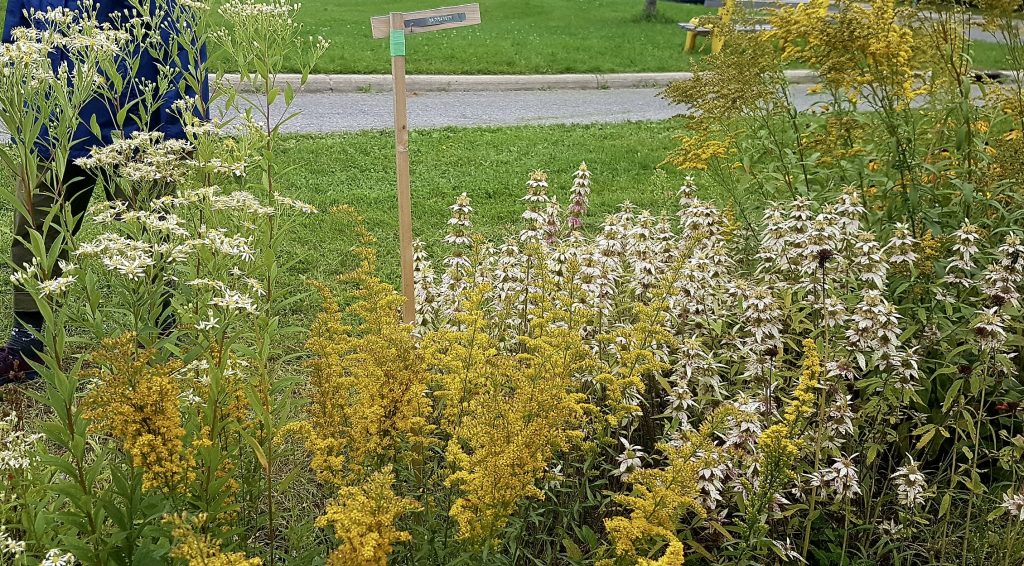by Berit Erickson
On August 26, the 7th Wild Pollinator Partners tour was held at Champlain Park’s pollinator and demonstration gardens. What a unique and epic project! It’s hard to believe that the site was once a paved parking lot. Volunteers Catherine Shearer and John Arnason hosted the tour, guiding captivated visitors through the gardens.

Catherine Shearer explains how the Champlain Park Miyawaki forest was planted. Photo by Pam Gullen.
In 2016, residents gained permission from the National Capital Commission (NCC) to create a network of recreational trails through nearby Champlain Woods. Then, in 2019, volunteers reclaimed the area between Champlain Woods and Champlain Park by manually de-paving it using pick-axes! Starting in 2020, a series of native plantings were added to beautify and rehabilitate this new greenspace.
Tiny Forest
We first visited the “tiny forest” at the east end (corner of Pontiac Street and Carleton Avenue). In 2020, more than 130 bare-root trees and shrubs of 27 different species were planted in a strip between the woods and an adjacent street. Volunteers used the Miyawaki method by planting a diverse variety of species densely to encourage competition and rapid growth. Shrubs were planted in front and trees in behind to mimic a forest edge. High school students watered the saplings every 2 days for the first year to ensure their survival. Eventually, when the trees and shrubs mature, their seeds will spread into the woods to increase species diversity there too.
Pollinator Garden
In October 2020, this garden was started near a well-travelled entrance to the Champlain Woods pathway. It has a circular mulch path, leading visitors through the planting, and is surrounded by a rope fence and stone edging to keep it tidy and contained. The garden includes a mix of plants including reliable local native plants like Black-eyed Susans, alvar plants like Hairy Beardtongue and Wild Columbine, western Ontario and Manitoba prairie species, and even non-native annuals such as Cosmos. This pollinator garden is lush, showy, and impressive.

John Arnason discusses the native plants included in the Champlain Park pollinator garden. Photo by Pam Cullen.
Carolinian and Ethnobotanical gardens
The terraced gardens are next, on the other side of the pathway entrance. Creating these terraced beds was a herculean task. Throughout 2020 and 2021, the space was excavated using pick-axes, soil was amended and raised up, and retaining walls were built using stones found during excavation. The beds now house two unique native plant gardens: the Carolinian Garden, and an Ethnobotanical Garden.
The Carolinian Garden was created with climate change in mind using species from the Niagara region. As the climate warms, some plant species that now thrive here will struggle, while other species that grow to the south will become hardy here. Southern species will naturally, but very slowly, spread north. Actively planting southern species here now will help them spread more quickly – a practice called assisted migration. The Carolinian Garden includes a Tulip Tree, Catalpa, Black Gum, Swamp Rose Mallow, Hop Tree, Pawpaw, Red Mulberries, and others.
The Ethnobotanical Garden is especially interesting, and tour participants had lots of questions. The Champlain Park gardens project is fortunate to have several botanists involved to contribute their expertise. University of Ottawa ethnobotanist, John Arnason, selecting native plant species for this garden that have indigenous medicinal uses. Species include Echinacea, Wild Senna, Sweetgrass, White Sage, Wintergreen, Sneezeweed, Sweet Flag, and Black Cohosh. The adjacent native plant Herb Garden features native edible plants, such as fruit-bearing Blueberry and Elderberry shrubs.

Raised beds were created for the Carolinian and Ethnobotanical gardens. That’s a Tulip Tree at the left, with Butterfly Weed and “nativar” of Swamp Rose Mallow blooming on either side of it. Photo by Sandy Garland.
Island beds
The tour ended with a look at the Rain Garden island bed and planters filled with native plants. Here, it was pointed out that in areas mown by the city, ensure that island beds have at least 5 feet of open grass around them for tractor mowers.

The Champlain Park island bed in full bloom: two species of goldenrod, Flat-topped Aster at the left and Spotted Beebalm toward the right. Photo by Pam Cullen.
Overcoming challenges
This project has not been without challenges. The most obvious one was the amount of strenuous manual labour required for de-paving and excavating compacted gravel beneath the asphalt. While some community gardens struggle even to find volunteers to weed, the Champlain Park project had lots of support. Their volunteer efforts are truly impressive.
Another significant challenge was poor soil; in some areas there was only a thin layer of soil over bedrock. To build up the soil for planting the pollinator garden, “hugelkultur” mounds of branches, wood chips, and leaves were added. For the Miyawaki planting, and the raised stone terrace, excavated gravel was amended with new soil and organic matter. Judging by the verdant plant growth, these soil-building efforts were very successful.
Buckthorn and other invasive plants were another serious problem. European Buckthorn is widespread in Champlain Woods and along the forest edge near the gardens. Shrubs were cut and chipped. To prevent regrowth, volunteers girdled the remaining trunks – removing all the bark to below the soil level starving the buckthorn roots. So far this approach has been remarkably effective.
With hard work and innovative, well-researched solutions, the Champlain Park gardens are an inspiring success. These attractive and educational plantings are now enjoyed by the community, insects, and wildlife.
For more information
To learn more about the creation of Champlain Park gardens, and for native plant lists for each garden, you can read an article, “Community stewardship and biodiversity enhancement of public greenspaces.” It’s available in the PDF version of the Ottawa Field Naturalists’ Trail and Landscape, Volume 57, Number 2, pages 126-144.
Communication is important, especially around a project of this size. Champlain Park volunteers invited city staff and councillors, NCC representatives, and interested people from Ecology Ottawa and the Enviro Centre to visit the gardens and talk about cooperation around environmental initiatives. See Ecology Ottawa’s blog post about the event.
Berit Erickson is a member of the Wild Pollinator Partners network and creator of The Corner Pollinator Garden and Wildlife Habitat.